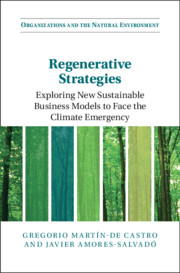Book contents
- Regenerative Strategies
- Organizations and the Natural Environment
- Regenerative Strategies
- Copyright page
- Contents
- Figures
- Tables
- Foreword: Reversing Course
- Acknowledgements
- 1 Introduction
- 2 Assessing the Response to the Climate Grand Challenge
- 3 Business as Usual
- 4 Sustainable Business Models
- 5 Climate Emergency in the Anthropocentric Era
- 6 The Regenerative Strategy
- 7 The Regenerative Strategy
- 8 Concluding Remarks
- Index
- References
3 - Business as Usual
A Review of Environmental Strategies
Published online by Cambridge University Press: 28 March 2024
- Regenerative Strategies
- Organizations and the Natural Environment
- Regenerative Strategies
- Copyright page
- Contents
- Figures
- Tables
- Foreword: Reversing Course
- Acknowledgements
- 1 Introduction
- 2 Assessing the Response to the Climate Grand Challenge
- 3 Business as Usual
- 4 Sustainable Business Models
- 5 Climate Emergency in the Anthropocentric Era
- 6 The Regenerative Strategy
- 7 The Regenerative Strategy
- 8 Concluding Remarks
- Index
- References
Summary
Chapter 3 carries out a critical review of environmental strategies, from reactive postures, such as pollution control, to the most proactive and advanced ones, such as pollution prevention and product stewardship. In doing so, the literature review shows the main theoretical streams used to frame different environmental strategic positionings, such as the institutional theory, the natural resource-based view, a new stakeholder theory or the microfoundations of strategy. To carry out a critical review of existing typologies of environmental strategies, they are deconstructed into their main features and dimensions following two research traditions: strategy (defenders, prospectors, analysers and reactors) and innovation (exploitation, exploration and ambidexterity). We conclude that these conventional approaches can be catalogued as ‘business-as-usual’ environmental strategies and finally present a disruptive alternative called the regenerative strategy.
Keywords
- Type
- Chapter
- Information
- Regenerative StrategiesExploring New Sustainable Business Models to Face the Climate Emergency, pp. 43 - 77Publisher: Cambridge University PressPrint publication year: 2024



